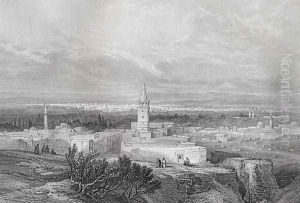Telbin, William Lewis Paintings
William Lewis Telbin, born in 1837 and deceased in 1902, was a distinguished British artist known for his exceptional skills in scenic painting, particularly in the realm of theatrical backdrops and panoramas. His work significantly contributed to the visual aesthetics of theater in the Victorian era, a period when dramatic arts were flourishing and evolving in exciting new directions. Telbin's artistry was not confined to a single genre but spanned various themes and styles, showcasing his versatility and depth as an artist.
Telbin's career was closely associated with the London theater scene, where he collaborated with numerous theaters, including the prestigious Drury Lane. His ability to create vivid, immersive scenes on canvas played a crucial role in the success of many productions, enhancing the audience's experience and transporting them to different worlds, from exotic landscapes to historical settings. Telbin's work was characterized by its meticulous attention to detail, vibrant color palettes, and an almost photographic realism, qualities that made his backdrops highly sought after by theater directors and producers of the time.
Beyond his contributions to theater, Telbin's talents were recognized and appreciated in other artistic circles. He was involved in the creation of dioramas and panoramas, large-scale, detailed paintings that were popular attractions in the 19th century, providing audiences with visual tours of far-off lands, significant historical events, or natural wonders. These works further demonstrated his skill in crafting detailed and realistic depictions of diverse subjects.
Despite his significant contributions to the art and theater of his time, William Lewis Telbin's name is not as widely recognized today as some of his contemporaries. However, his work continues to be studied and admired by those interested in the history of scenic design and the visual arts of the Victorian era. His legacy is preserved in the collections of museums and archives that hold examples of his work and in the memories of the groundbreaking theatrical productions he helped bring to life.
